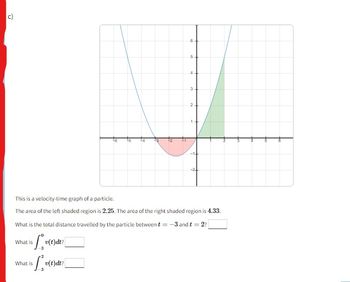b) This is a velocity-time graph of a particle. The area of the left shaded region is 6. The area of the right shaded region is 10.7. What is v(t)dt What is 2 3 v(t)dt?
b) This is a velocity-time graph of a particle. The area of the left shaded region is 6. The area of the right shaded region is 10.7. What is v(t)dt What is 2 3 v(t)dt?
Advanced Engineering Mathematics
10th Edition
ISBN:9780470458365
Author:Erwin Kreyszig
Publisher:Erwin Kreyszig
Chapter2: Second-order Linear Odes
Section: Chapter Questions
Problem 1RQ
Related questions
Question

Transcribed Image Text:b)
This is a velocity-time graph of a particle.
The area of the left shaded region is 6. The area of the right shaded region is 10.7.
What is v(t)dt _
What is
-2
.3
-2
v(t)dt?

Transcribed Image Text:a)
Select those options which are correct/true. v(t) is the velocity of some object.
10
v(t)dt is the distance travelled from t = 0 tot = 10.
To get from velocity to position, you have to integrate.
To get from velocity to position, you differentiate
10
a v(t)dt is the change in position from t = 0 tot = 10.
To calculate change in position based on area, you need to think about whether vis
positive or negative for the different areas.
In a velocity-time graph, areas are equal to distance travelled
In a position-time graph, areas are equal to distance travelled
In a position-time graph, gradients are equal to speeds
Expert Solution
Step 1: Explanation
Since you have posted multiple questions, as per our company guidelines we will solve only the first problem. In order to get a solution for the remaining parts you need to post the question again mentioning the questions to be solved.
Step by step
Solved in 3 steps with 1 images

Follow-up Questions
Read through expert solutions to related follow-up questions below.
Follow-up Question
below attached is part C can you alos do that

Transcribed Image Text:ū
What is
is [₁ v(t)dt?
-3
6
What is
5
4
3+
2
This is a velocity-time graph of a particle.
The area of the left shaded region is 2.25. The area of the right shaded region is 4.33.
What is the total distance travelled by the particle between t = -3 and t = 2?
is [v(t)dt? [
-3
-1+
-2+
Solution
Recommended textbooks for you

Advanced Engineering Mathematics
Advanced Math
ISBN:
9780470458365
Author:
Erwin Kreyszig
Publisher:
Wiley, John & Sons, Incorporated

Numerical Methods for Engineers
Advanced Math
ISBN:
9780073397924
Author:
Steven C. Chapra Dr., Raymond P. Canale
Publisher:
McGraw-Hill Education

Introductory Mathematics for Engineering Applicat…
Advanced Math
ISBN:
9781118141809
Author:
Nathan Klingbeil
Publisher:
WILEY

Advanced Engineering Mathematics
Advanced Math
ISBN:
9780470458365
Author:
Erwin Kreyszig
Publisher:
Wiley, John & Sons, Incorporated

Numerical Methods for Engineers
Advanced Math
ISBN:
9780073397924
Author:
Steven C. Chapra Dr., Raymond P. Canale
Publisher:
McGraw-Hill Education

Introductory Mathematics for Engineering Applicat…
Advanced Math
ISBN:
9781118141809
Author:
Nathan Klingbeil
Publisher:
WILEY

Mathematics For Machine Technology
Advanced Math
ISBN:
9781337798310
Author:
Peterson, John.
Publisher:
Cengage Learning,

